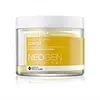What's inside
What's inside
 Key Ingredients
Key Ingredients

 Benefits
Benefits

 Concerns
Concerns

No concerns
 Ingredients Side-by-side
Ingredients Side-by-side

Water
Skin ConditioningGlycerin
HumectantButylene Glycol
HumectantCentella Asiatica Extract
CleansingDipropylene Glycol
Humectant1,2-Hexanediol
Skin ConditioningAsiaticoside
AntioxidantAsiatic Acid
Skin ConditioningMadecassic Acid
Skin ConditioningMadecassoside
AntioxidantLactobionic Acid
BufferingGluconolactone
Skin ConditioningHyaluronic Acid
HumectantHydrolyzed Hyaluronic Acid
HumectantSodium Hyaluronate
HumectantOctyldodecanol
EmollientCeramide NP
Skin ConditioningHydrogenated Lecithin
EmulsifyingCaprylic/Capric Triglyceride
MaskingAllantoin
Skin ConditioningBetaine
HumectantPanthenol
Skin ConditioningCetearyl Olivate
Sorbitan Olivate
EmulsifyingGlyceryl Caprylate
EmollientEthylhexylglycerin
Skin ConditioningTromethamine
BufferingAcrylates/C10-30 Alkyl Acrylate Crosspolymer
Emulsion StabilisingXanthan Gum
EmulsifyingPropanediol
SolventDiglycerin
HumectantCitrus Aurantium Bergamia Fruit Oil
MaskingDisodium EDTA
Water, Glycerin, Butylene Glycol, Centella Asiatica Extract, Dipropylene Glycol, 1,2-Hexanediol, Asiaticoside, Asiatic Acid, Madecassic Acid, Madecassoside, Lactobionic Acid, Gluconolactone, Hyaluronic Acid, Hydrolyzed Hyaluronic Acid, Sodium Hyaluronate, Octyldodecanol, Ceramide NP, Hydrogenated Lecithin, Caprylic/Capric Triglyceride, Allantoin, Betaine, Panthenol, Cetearyl Olivate, Sorbitan Olivate, Glyceryl Caprylate, Ethylhexylglycerin, Tromethamine, Acrylates/C10-30 Alkyl Acrylate Crosspolymer, Xanthan Gum, Propanediol, Diglycerin, Citrus Aurantium Bergamia Fruit Oil, Disodium EDTA
Water
Skin ConditioningButylene Glycol
HumectantGlycerin
HumectantCitrus Limon Fruit Extract
MaskingPhenoxyethanol
PreservativeEthylhexylglycerin
Skin ConditioningAlcohol Denat.
AntimicrobialPEG/PPG-17/6 Copolymer
SolventSodium Hyaluronate
HumectantMelissa Officinalis Leaf Extract
Skin ConditioningCymbopogon Citratus Extract
Skin ConditioningCitrus Unshiu Peel Extract
MaskingCitrus Aurantium Dulcis Fruit Extract
MaskingCarica Papaya Fruit Extract
Skin ConditioningTricholoma Matsutake Extract
Skin ConditioningCordyceps Sinensis Extract
AntioxidantCitrus Paradisi Fruit Extract
Skin ConditioningPisum Sativum Extract
Skin ConditioningGlycine Soja Seed Extract
Skin ConditioningVitis Vinifera Fruit Extract
Skin ConditioningSaururus Chinensis Leaf/Root Extract
AntimicrobialArnica Montana Flower Extract
MaskingArtemisia Absinthium Extract
Skin ConditioningBroussonetia Kazinoki Bark Extract
Skin ConditioningCoptis Chinensis Root Extract
AntioxidantPEG-60 Hydrogenated Castor Oil
EmulsifyingCarbomer
Emulsion StabilisingTartaric Acid
BufferingGlycolic Acid
BufferingLactic Acid
BufferingTromethamine
BufferingDisodium EDTA
Benzophenone-5
UV AbsorberCI 19140
Cosmetic ColorantCI 17200
Cosmetic ColorantParfum
MaskingWater, Butylene Glycol, Glycerin, Citrus Limon Fruit Extract, Phenoxyethanol, Ethylhexylglycerin, Alcohol Denat., PEG/PPG-17/6 Copolymer, Sodium Hyaluronate, Melissa Officinalis Leaf Extract, Cymbopogon Citratus Extract, Citrus Unshiu Peel Extract, Citrus Aurantium Dulcis Fruit Extract, Carica Papaya Fruit Extract, Tricholoma Matsutake Extract, Cordyceps Sinensis Extract, Citrus Paradisi Fruit Extract, Pisum Sativum Extract, Glycine Soja Seed Extract, Vitis Vinifera Fruit Extract, Saururus Chinensis Leaf/Root Extract, Arnica Montana Flower Extract, Artemisia Absinthium Extract, Broussonetia Kazinoki Bark Extract, Coptis Chinensis Root Extract, PEG-60 Hydrogenated Castor Oil, Carbomer, Tartaric Acid, Glycolic Acid, Lactic Acid, Tromethamine, Disodium EDTA, Benzophenone-5, CI 19140, CI 17200, Parfum
 Reviews
Reviews

Ingredients Explained
These ingredients are found in both products.
Ingredients higher up in an ingredient list are typically present in a larger amount.
Butylene Glycol (or BG) is used within cosmetic products for a few different reasons:
Overall, Butylene Glycol is a safe and well-rounded ingredient that works well with other ingredients.
Though this ingredient works well with most skin types, some people with sensitive skin may experience a reaction such as allergic rashes, closed comedones, or itchiness.
Learn more about Butylene GlycolDisodium EDTA plays a role in making products more stable by aiding other preservatives.
It is a chelating agent, meaning it neutralizes metal ions that may be found in a product.
Disodium EDTA is a salt of edetic acid and is found to be safe in cosmetic ingredients.
Learn more about Disodium EDTAEthylhexylglycerin (we can't pronounce this either) is commonly used as a preservative and skin softener. It is derived from glyceryl.
You might see Ethylhexylglycerin often paired with other preservatives such as phenoxyethanol. Ethylhexylglycerin has been found to increase the effectiveness of these other preservatives.
Glycerin is already naturally found in your skin. It helps moisturize and protect your skin.
A study from 2016 found glycerin to be more effective as a humectant than AHAs and hyaluronic acid.
As a humectant, it helps the skin stay hydrated by pulling moisture to your skin. The low molecular weight of glycerin allows it to pull moisture into the deeper layers of your skin.
Hydrated skin improves your skin barrier; Your skin barrier helps protect against irritants and bacteria.
Glycerin has also been found to have antimicrobial and antiviral properties. Due to these properties, glycerin is often used in wound and burn treatments.
In cosmetics, glycerin is usually derived from plants such as soybean or palm. However, it can also be sourced from animals, such as tallow or animal fat.
This ingredient is organic, colorless, odorless, and non-toxic.
Glycerin is the name for this ingredient in American English. British English uses Glycerol/Glycerine.
Learn more about GlycerinSodium Hyaluronate is hyaluronic acid's salt form. It is commonly derived from the sodium salt of hyaluronic acid.
Like hyaluronic acid, it is great at holding water and acts as a humectant. This makes it a great skin hydrating ingredient.
Sodium Hyaluronate is naturally occurring in our bodies and is mostly found in eye fluid and joints.
These are some other common types of Hyaluronic Acid:
Learn more about Sodium HyaluronateTromethamine helps balance the pH and improve the texture of a product. It is synthetically created.
As an emulsifier, Tromethamine prevents oil and water ingredients from separating. This helps stabilize the product and elongate a product's shelf life. Tromethamine also makes a product thicker.
Tromethamine helps balance the pH level of a product. Normal pH level of skin is slightly acidic (~4.75-5.5). The acidity of our skin is maintained by our glands and skin biome. Being slightly acidic allows our skin to create an "acid mantle". This acid mantle is a thin barrier that protects our skin from bacteria and contaminants.
Oral Tromethanmine is an anti-inflammatory drug but plays the role of masking, adding fragrance, and/or balancing pH in skincare.
1,3-Propanediol, 2-amino-2-(hydroxymethyl)-
Learn more about TromethamineWater. It's the most common cosmetic ingredient of all. You'll usually see it at the top of ingredient lists, meaning that it makes up the largest part of the product.
So why is it so popular? Water most often acts as a solvent - this means that it helps dissolve other ingredients into the formulation.
You'll also recognize water as that liquid we all need to stay alive. If you see this, drink a glass of water. Stay hydrated!
Learn more about Water